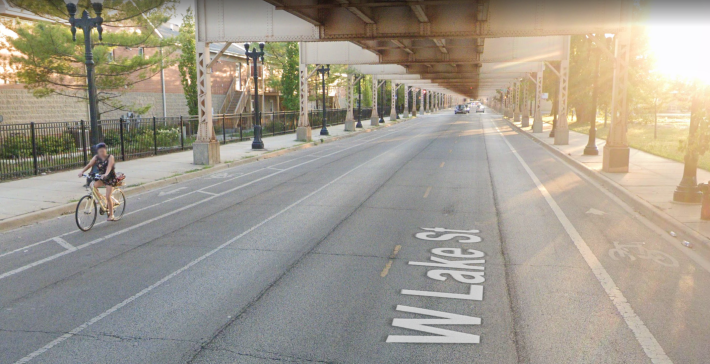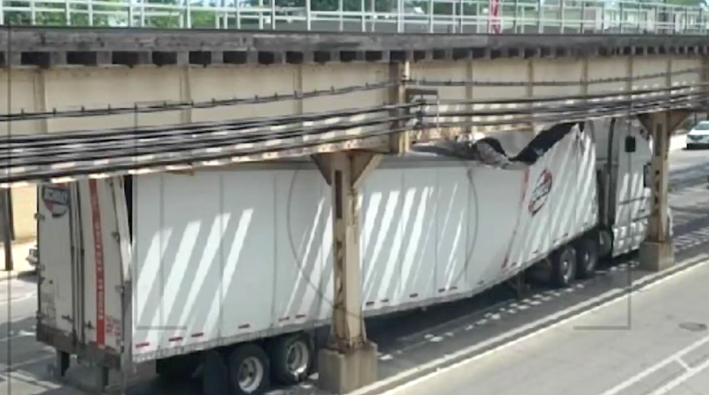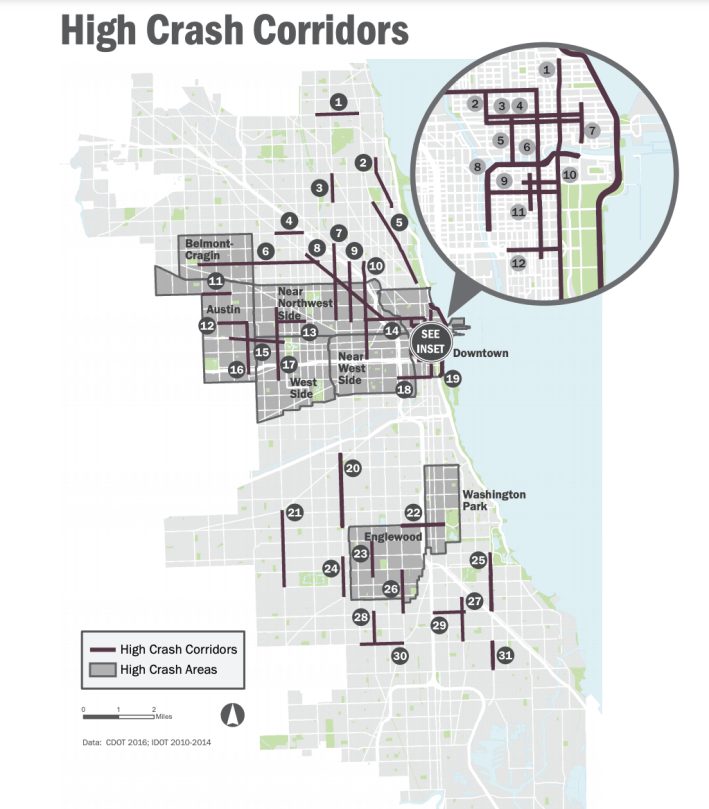Update 8/31/21, 10:30 AM: In an email from the Fulton Market Association shared with Streetsblog, director Roger Romanelli in effect calls for removing the protected bike lane on Lake Street between Damen and Western avenues. "More street parking is needed [here]. Only south side parking is allowed now. North side parking is needed too." There is insufficient road width to add parking to the north side of Lake without eliminating the protected bike lane.

It's wild how local news outlets keep publicizing Fulton Market Association director Roger Romanelli's proposal to spend billions in federal transit funds to rebuild the Lake Street Green Line tracks in order to facilitate driving. What's even more baffling is that the reporters gave him ink and airtime without asking any actual transportation experts or advocates about his plan.
Streetblog readers know Romanelli as the activist who helped kill Chicago's Ashland Avenue bus rapid transit proposal. Now residing in west-suburban Hillside, where he unsuccessfully ran for village trustee earlier this year (garnering less than 9 percent of the vote), he's currently fighting a state project to improve safety on the Illinois Prairie Path.
The Sun-Times ran a rather incurious piece on Romanelli's Lake Street campaign, which calls for spending $1.8 billion of the roughly $15 billion in federal infrastructure money slated for Illinois to raise the tracks between Laramie (5200 W.) and Talman (2630 W.) avenues, and relocate support columns that are currently in the middle of the road to the sidewalk. The article quoted local congressman Danny Davis as endorsing the plan. But here's a sample of what experts and advocates Streetsblog contacted had to say:
- Transportation consultant Steve Schlickman: "Given that the Green Line was overhauled in the 1990s, it is too early in its remaining useful life to reinvest billions in it."
- Active Transportation Alliance: "There are many projects that have gone through more public vetting and provide more clear community benefit than this Lake Street plan.”
- Metropolitan Planning Council: "We need to move away from a politically driven process where people that yell the loudest get the most attention."
But in a new "investigative report," NBC was glad to give Romanelli a megaphone without bothering to fact-check his claims. "You have a three-mile section that's the most dangerous street in Chicago, and it's probably the most dangerous street in Illinois," he asserted during the segment.
It's unclear where Romanelli got that statistic, other than his hat. It's true that Chicago's Vision Zero plan identifies Lake between Lockwood (5300 W.) and Hamlin (3800 W.) as one of many High Crash Corridors across the city.
But in 2014 when the Active Transportation Alliance did statistical analysis and published a list of Chicago's most ten most dangerous intersections, none of them were on Lake Street.
And the stretch of Lake Romanelli is focusing on as "the most dangerous street in Chicago" isn't even the road in the immediate area that has seen the most crashes. According to Illinois Department of transportation crash data, from September 2017 through August 2021, there were 1,500 crashes on Lake between Laramie and Talman, but there were 1,942 crashes on Madison Street, two blocks south, between Laramie and Talman.
Granted, NBC reports that 11 of the 18 crashes in the past year where truck drivers got stuck under Chicago 'L' tracks happened on Lake. And since the trucking industry is one of the Fulton Market Association's main constituencies, naturally this issue is one of Romanelli's pet peeves.
But that doesn't mean we should be using limited federal transit funds to rebuild the tracks to accommodate truckers, which would have zero benefit for 'L' riders. After all, the $1.8 billion Romanelli wants is in the same ballpark as the $2.3 billion needed for the entire south Red Line extension from 95th to 130th Street. That is, building an entirely new 'L' branch and four stations, rather than reconstructing an existing one that was rebuilt not that long ago.

Romanelli indicated during the report he might be willing to setting for new signs explaining to truckers that turning east or west under the 'L' tracks may put them at risk of tearing off the tops of their trailers. That would be a reasonable, inexpensive solution.
But in reality Romanelli's proposal to rebuild the tracks to make driving easier is a road project. As such, he should be pursuing road funding for it, not transit money.





